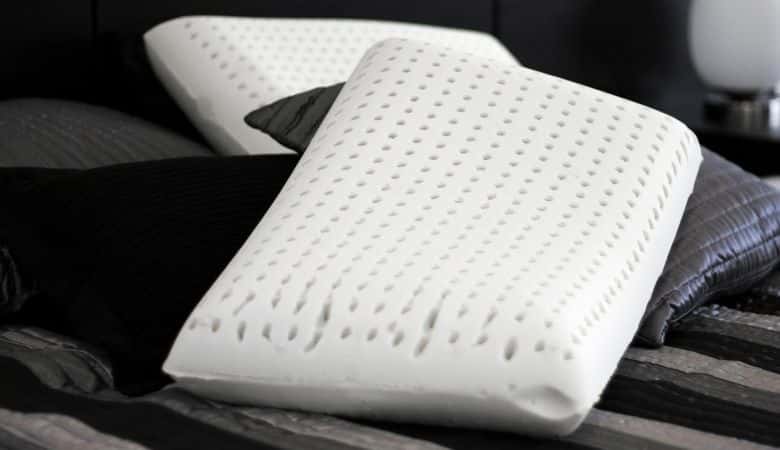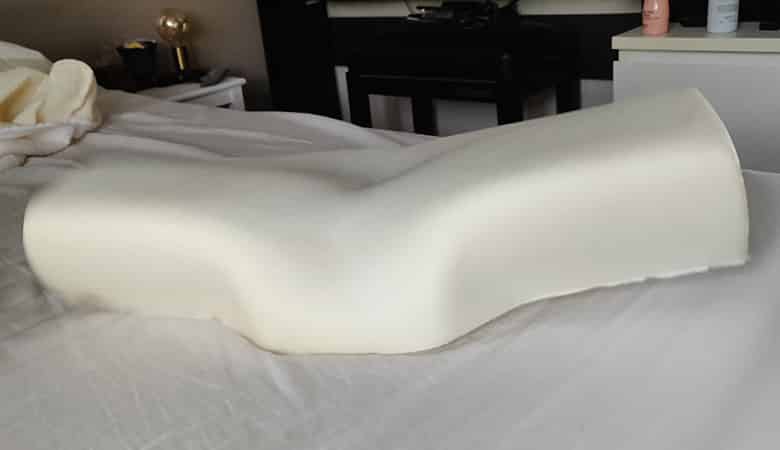This post is part of the complete latex pillow buyers guide
Are you looking for the perfect pillow?
Well, you should be. When it comes to maximizing your sleep potential, your pillow plays an important role. But there are many different types of pillows, and finding the right one can be hard.
For instance, when it comes to latex versus memory foam pillows, what’s the difference, and which is better?
The major differences between latex and memory foam is that with latex you have an option for all natural material, memory foam is initially firmer than latex, but latex sleeps cooler, and they also have different price points.
There are more differences between latex and memory foam. In this post we list all of these differences as well as the pros and cons that comes with each of them. So, read on to learn more.
About Memory Foam and Latex

Originally created for NASA to make spaceship seats more comfortable, memory foam is man-made from viscoelastic polyurethane. Memory foam never made it to space, but it has been used widely throughout the world.
It was first used as wheelchair seat cushions and post-surgery padding in hospitals. One of the reasons for this type of use is because even though memory foam is firm to the touch, it softens in response to body heat. It adjusts around pressure and is slow to bounce back, giving it that cushiony feel.
Latex is a natural type of foam material. It’s made from the sap of the rubber tree, Hevea brasiliensis. The sap is foamed to create many tiny air bubbles. That is what gives the foam its soft, bouncy texture.
Although latex is a natural material, other materials mixed with it are common to find these days, forming synthetic latex. Synthetic latex can feel similar to natural latex, but it’s not as durable. Latex is naturally cool and bouncy.
Both types of pillows come in solid, shredded, and a shredded blend.
How Are They Similar?
Latex and memory foam pillows have quite a few similarities. They are both high-density options when it comes to relieving pressure points. They help with pain by offering uniform support to the head and neck.
They are both more durable than most other pillows.
Neither pillow requires fluffing since they each hold their original shape.
How Are They Different?
If you’re looking for a pillow with natural materials, that would be latex. Given latex can be natural or synthetic, you can choose your preference. However, memory foam is a man-made product only, made with carcinogens that can be harmful to your health.
Another difference is in how they respond. Memory foam has a slower response to pressure than latex does. It’s initially much firmer than latex. That’s not a totally bad difference; it just depends on your preference. Many people prefer memory foam because of how it responds and how it eases neck pain.
Latex promotes more air flow and sleeps cooler than memory foam.
Latex pillows are hypoallergenic, resistant to mold, mildew, and dust mites. Memory foam pillows are not hypoallergenic.
While both types of pillows provide the support needed for neck pain, latex pillows are a little more expensive than memory foam.
What if I Sleep on My Side … Back … or Stomach?
Since the type of pillow you have plays such an important role in maintaining proper alignment while you’re sleeping, doesn’t it make sense to have the pillow that works best for how you sleep?
Most of us are slide sleepers, but others sleep on their back or their stomach. Believe it or not, there’s a best pillow for that, too. We’ll look at whether a latex or memory foam works best for your sleep position.
Side Sleeper
Almost ¾ of people everywhere sleep on their side. That is not a bad position for spinal alignment, but it can cause pressure on your joints and back.
Sleeping on your side can leave your head much higher than the mattress, so the pillow you use should have enough loft to keep your neck and upper back aligned. The high loft is important which is why firm memory foam pillows or high loft latex foam pillows are ideal for this position.
Back Sleeper
About 10% of us prefer sleeping on our backs. While it’s not many, you still have reason to ensure a restful night. Sleeping on your back is great for spinal alignment and overall health and is the recommended position for anyone suffering from neck pain or poor circulation.
Sleeping on your back can sometimes pull your neck out of alignment, so having a pillow that supports your neck and head is important. A pillow with a higher loft is ideal for back sleepers, and medium memory foam pillows are an ideal choice or medium-firm latex foam pillows.
Stomach Sleeper
Less than 20% of us are stomach sleepers, but it is still more common than sleeping on your back. That is actually the worst position for spinal alignment, so it’s not recommended. Sleeping on your stomach forces your neck and upper body to curve unnaturally, so it’s recommended that if you have to sleep on your stomach to prop your body with a large body pillow to reduce excessive twisting.
You also want to ensure there’s no excessive pressure on your neck, jaw, or shoulders while you’re sleeping. Latex foam pillows would probably work better than regular memory foam pillows. However, shredded foam pillows are another good option.
What Are The Benefits?

Both types of pillows come with their unique benefits:
Memory Foam
- Memory foam pillows offer great body contouring, meaning they conform to the contours of your head and neck to evenly distribute your weight and relieve pressure. That is why memory foam pillows are a top choice for neck and back pain.
- Memory foam pillows are also good at absorbing motion. So, if you share a bed with someone, you won’t even be disturbed by their movement.
Latex
- Latex is one of the most durable pillows available; it’s also much softer to the touch than memory foam. Memory foam can be firm initially; it takes a while to soften up. That is quite the opposite with latex.
- Unlike memory foam, latex tends to keep you cool throughout the night. It’s one of the most cooling pillow materials available.
- Latex’s natural material helps it to be anti-fungal, mildew resistant, and hypoallergenic. That makes the pillow more ideal for people with allergies.
What Are Some Disadvantages?

Memory Foam
- One of the drawbacks known of memory foam is it can trap body heat and water. That can make it uncomfortable in the middle of the night for most sleepers, especially in warm seasons. To counter this drawback, the makers of memory foam developed gel-infused memory foam to provide more coolness at night.
- It also may not be a good idea for small children to sleep on memory foam, as they can get stuck in the contours and struggle to breathe.
- Memory foam produces an unpleasant off-gassing scent that comes by way of the carcinogens manufactured into the material. The carcinogens can be harmful if breathed in at high levels for a long time. Off-gassing can also be harmful to people with allergies. Thankfully, the scent usually dissipates before considerable harm is possible.
Latex
- Latex may have an initial foam smell that some find unpleasant. However, just as with memory foam, the scent will eventually dissipate on its own after a few days.
- While memory foam was ergonomically designed, latex was not. Even though it does help with relieving pressure, it may not be as effective as memory foam.
- The price point of latex pillows may be a deal-breaker for some, but given the durability and quality they bring, maybe not.
- Latex material is all-natural. However, because of the different types of pillows made these days, some latex pillows are also mixed with other materials, making them synthetic and not 100% natural. If you choose to sleep on latex because you’re looking for a natural option, make sure it is 100% latex and not synthetic.
Which One is Better?
The better pillow is the one that best meets your unique needs. Do you have pressure points? Allergies? Get hot at night? A side sleeper? These are all good questions to ask yourself as you decide on which pillow that’s best for you.
Latex Pillows: A complete buyers guide – Parts:
1. Why Should You Use A Latex Pillow? The Pros and Cons
2. Latex vs Memory Foam Pillows: What’s the difference and which is better?
3. Are Latex Pillows Safe? What about the smell?
4. How Long Do Latex Pillows Last? This is the replacement time
5. How to Wash And Dry a Latex Pillow: Step by step guide
6. Best Latex Pillows of 2021 – Full Guide and Review
